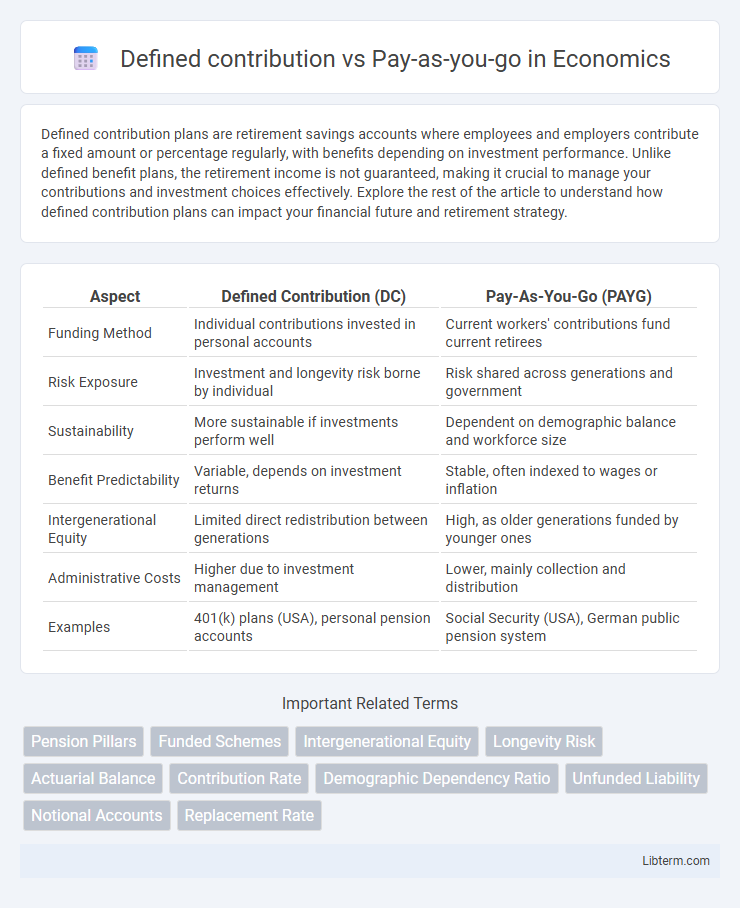Defined contribution plans are retirement savings accounts where employees and employers contribute a fixed amount or percentage regularly, with benefits depending on investment performance. Unlike defined benefit plans, the retirement income is not guaranteed, making it crucial to manage your contributions and investment choices effectively. Explore the rest of the article to understand how defined contribution plans can impact your financial future and retirement strategy.
Table of Comparison
| Aspect | Defined Contribution (DC) | Pay-As-You-Go (PAYG) |
|---|---|---|
| Funding Method | Individual contributions invested in personal accounts | Current workers' contributions fund current retirees |
| Risk Exposure | Investment and longevity risk borne by individual | Risk shared across generations and government |
| Sustainability | More sustainable if investments perform well | Dependent on demographic balance and workforce size |
| Benefit Predictability | Variable, depends on investment returns | Stable, often indexed to wages or inflation |
| Intergenerational Equity | Limited direct redistribution between generations | High, as older generations funded by younger ones |
| Administrative Costs | Higher due to investment management | Lower, mainly collection and distribution |
| Examples | 401(k) plans (USA), personal pension accounts | Social Security (USA), German public pension system |
Introduction to Defined Contribution and Pay-As-You-Go Systems
Defined contribution systems involve individual accounts where employees and employers contribute fixed amounts, accumulating funds for retirement benefits based on investment performance. Pay-as-you-go (PAYG) systems finance current retirees' benefits directly from the payroll taxes of current workers, relying on demographic support ratios. These contrasting frameworks highlight funding mechanisms, with defined contribution plans emphasizing personal savings and investment risk, while PAYG systems depend on intergenerational transfers within a population.
Key Differences Between Defined Contribution and Pay-As-You-Go
Defined contribution plans involve individual accounts where employees and employers contribute fixed amounts, accumulating funds invested for future retirement benefits, while pay-as-you-go systems finance current retirees through taxes on the working population without accumulating individual savings. Key differences include the accumulation of assets in defined contribution plans versus the immediate distribution of funds in pay-as-you-go systems, and the investment risk borne by individuals in defined contribution plans compared to the demographic and fiscal risks managed by governments in pay-as-you-go schemes. These structural distinctions affect sustainability, benefit predictability, and the financial burden distribution across generations.
How Defined Contribution Plans Work
Defined contribution plans operate by allowing employees to contribute a fixed percentage of their salary into individual retirement accounts, with employers often matching contributions up to a certain limit. These funds are invested in various assets, such as stocks and bonds, and the retirement benefit depends on the accumulated account value and investment performance. Unlike pay-as-you-go systems, where current workers fund retirees' benefits directly, defined contribution plans build personal savings over time, offering greater portability and control for employees.
How Pay-As-You-Go Systems Operate
Pay-as-you-go (PAYG) systems operate by funding current retirees' benefits through the contributions collected from the current working population. These systems rely on a continuous inflow of payroll taxes or social security contributions, with no accumulation of individual savings or investment returns. The sustainability of PAYG pension schemes depends heavily on demographic factors such as the ratio of active workers to retirees and overall economic growth.
Advantages of Defined Contribution Schemes
Defined contribution schemes offer individual control over retirement savings, allowing participants to tailor investments according to risk tolerance and financial goals. These plans provide transparency with clear account balances and are portable across employers, enhancing flexibility for workers. Unlike pay-as-you-go systems, defined contribution schemes reduce dependency on future workforce contributions and mitigate fiscal pressures on government budgets.
Advantages of Pay-As-You-Go Schemes
Pay-as-you-go (PAYG) pension schemes offer the advantage of providing immediate funding for current retirees by using the contributions of the active workforce, ensuring continuous cash flow without requiring large capital reserves. This system promotes intergenerational solidarity, distributing retirement benefits based on current economic conditions and demographic factors. PAYG schemes adapt to changing workforce dynamics, allowing governments to adjust contribution rates and benefits in response to economic shifts, enhancing fiscal flexibility.
Challenges Facing Defined Contribution Models
Defined contribution models face challenges such as investment risk borne by individuals, potentially leading to inadequate retirement savings in volatile markets. Unlike pay-as-you-go systems that rely on current workforce contributions, defined contribution plans require consistent and adequate individual contributions to ensure financial sustainability. The complexity of investment choices and the variability in retirement outcomes emphasize the need for improved financial literacy and regulatory oversight.
Risks and Limitations of Pay-As-You-Go Systems
Pay-As-You-Go (PAYG) pension systems face significant risks including demographic shifts such as aging populations and declining birth rates, which strain financial sustainability by increasing beneficiaries relative to contributors. Economic fluctuations and political factors may cause funding deficits and volatility, jeopardizing retirees' income security. Unlike defined contribution plans that accumulate individual savings, PAYG systems lack reserve funds, making them vulnerable to insolvency and intergenerational equity concerns.
Global Trends in Pension System Reforms
Global trends in pension system reforms emphasize a shift from traditional Pay-as-you-go (PAYG) models towards Defined Contribution (DC) schemes, driven by demographic changes such as aging populations and increasing life expectancy. Countries across Europe, Latin America, and Asia are adopting DC plans to enhance sustainability, reduce fiscal burdens, and promote individual retirement savings. These reforms aim to balance fiscal responsibility with retirement income security by encouraging private pension fund growth and diversified investment portfolios.
Choosing the Right Approach for Sustainable Retirement
Defined contribution plans offer individuals control over their retirement savings, allowing investment growth tailored to personal risk tolerance and financial goals. Pay-as-you-go systems rely on current workers' contributions to fund retirees, creating intergenerational dependencies that can strain sustainability amid demographic shifts. Selecting the right approach requires analyzing factors such as population aging, workforce size, and economic stability to ensure long-term retirement security.
Defined contribution Infographic

 libterm.com
libterm.com